Nursing - Elderly Patient Care in Canada
VerifiedAdded on 2022/08/13
|8
|1865
|16
AI Summary
Contribute Materials
Your contribution can guide someone’s learning journey. Share your
documents today.
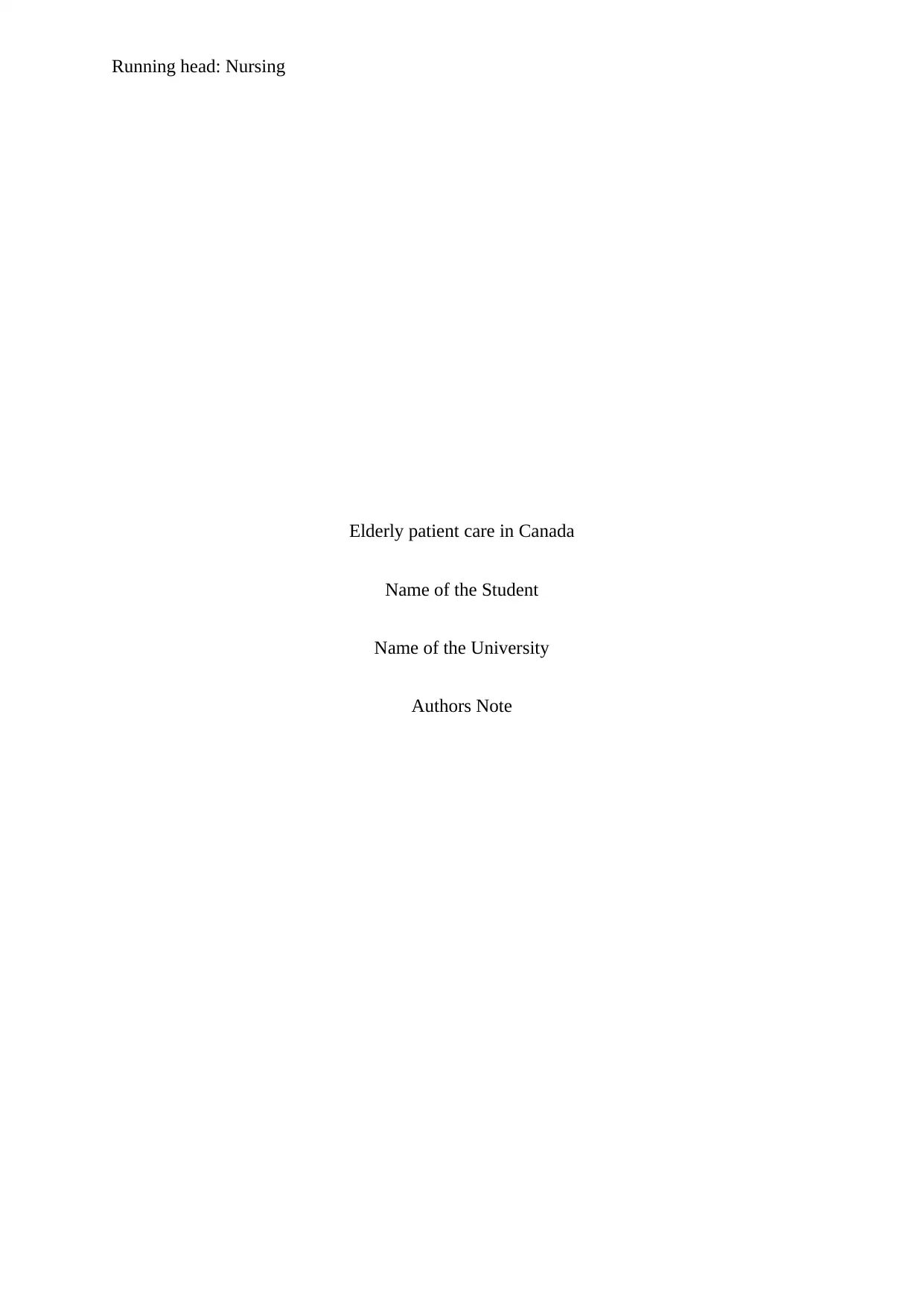
Running head: Nursing
Elderly patient care in Canada
Name of the Student
Name of the University
Authors Note
Elderly patient care in Canada
Name of the Student
Name of the University
Authors Note
Secure Best Marks with AI Grader
Need help grading? Try our AI Grader for instant feedback on your assignments.
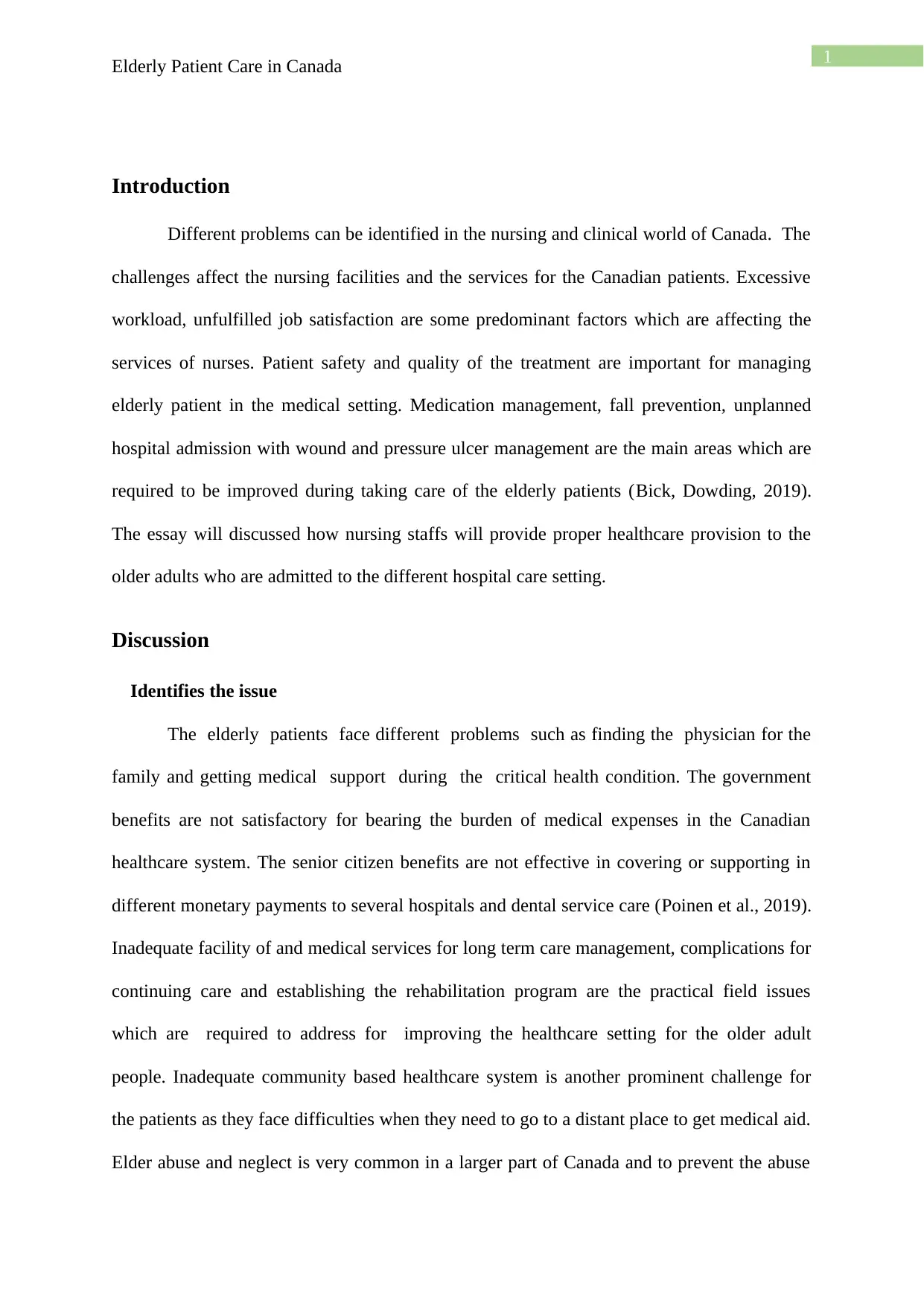
1
Elderly Patient Care in Canada
Introduction
Different problems can be identified in the nursing and clinical world of Canada. The
challenges affect the nursing facilities and the services for the Canadian patients. Excessive
workload, unfulfilled job satisfaction are some predominant factors which are affecting the
services of nurses. Patient safety and quality of the treatment are important for managing
elderly patient in the medical setting. Medication management, fall prevention, unplanned
hospital admission with wound and pressure ulcer management are the main areas which are
required to be improved during taking care of the elderly patients (Bick, Dowding, 2019).
The essay will discussed how nursing staffs will provide proper healthcare provision to the
older adults who are admitted to the different hospital care setting.
Discussion
Identifies the issue
The elderly patients face different problems such as finding the physician for the
family and getting medical support during the critical health condition. The government
benefits are not satisfactory for bearing the burden of medical expenses in the Canadian
healthcare system. The senior citizen benefits are not effective in covering or supporting in
different monetary payments to several hospitals and dental service care (Poinen et al., 2019).
Inadequate facility of and medical services for long term care management, complications for
continuing care and establishing the rehabilitation program are the practical field issues
which are required to address for improving the healthcare setting for the older adult
people. Inadequate community based healthcare system is another prominent challenge for
the patients as they face difficulties when they need to go to a distant place to get medical aid.
Elder abuse and neglect is very common in a larger part of Canada and to prevent the abuse
Elderly Patient Care in Canada
Introduction
Different problems can be identified in the nursing and clinical world of Canada. The
challenges affect the nursing facilities and the services for the Canadian patients. Excessive
workload, unfulfilled job satisfaction are some predominant factors which are affecting the
services of nurses. Patient safety and quality of the treatment are important for managing
elderly patient in the medical setting. Medication management, fall prevention, unplanned
hospital admission with wound and pressure ulcer management are the main areas which are
required to be improved during taking care of the elderly patients (Bick, Dowding, 2019).
The essay will discussed how nursing staffs will provide proper healthcare provision to the
older adults who are admitted to the different hospital care setting.
Discussion
Identifies the issue
The elderly patients face different problems such as finding the physician for the
family and getting medical support during the critical health condition. The government
benefits are not satisfactory for bearing the burden of medical expenses in the Canadian
healthcare system. The senior citizen benefits are not effective in covering or supporting in
different monetary payments to several hospitals and dental service care (Poinen et al., 2019).
Inadequate facility of and medical services for long term care management, complications for
continuing care and establishing the rehabilitation program are the practical field issues
which are required to address for improving the healthcare setting for the older adult
people. Inadequate community based healthcare system is another prominent challenge for
the patients as they face difficulties when they need to go to a distant place to get medical aid.
Elder abuse and neglect is very common in a larger part of Canada and to prevent the abuse
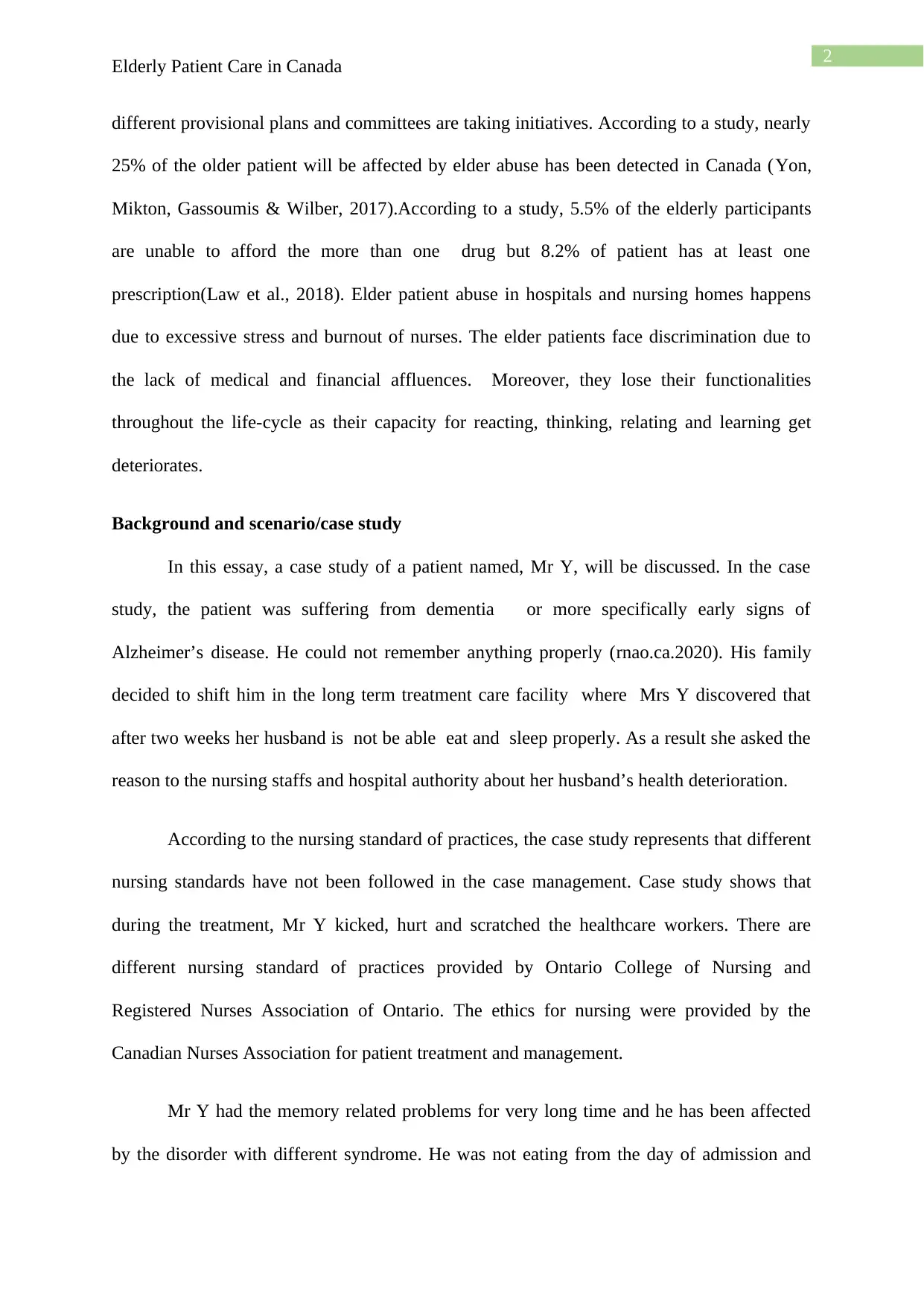
2
Elderly Patient Care in Canada
different provisional plans and committees are taking initiatives. According to a study, nearly
25% of the older patient will be affected by elder abuse has been detected in Canada (Yon,
Mikton, Gassoumis & Wilber, 2017).According to a study, 5.5% of the elderly participants
are unable to afford the more than one drug but 8.2% of patient has at least one
prescription(Law et al., 2018). Elder patient abuse in hospitals and nursing homes happens
due to excessive stress and burnout of nurses. The elder patients face discrimination due to
the lack of medical and financial affluences. Moreover, they lose their functionalities
throughout the life-cycle as their capacity for reacting, thinking, relating and learning get
deteriorates.
Background and scenario/case study
In this essay, a case study of a patient named, Mr Y, will be discussed. In the case
study, the patient was suffering from dementia or more specifically early signs of
Alzheimer’s disease. He could not remember anything properly (rnao.ca.2020). His family
decided to shift him in the long term treatment care facility where Mrs Y discovered that
after two weeks her husband is not be able eat and sleep properly. As a result she asked the
reason to the nursing staffs and hospital authority about her husband’s health deterioration.
According to the nursing standard of practices, the case study represents that different
nursing standards have not been followed in the case management. Case study shows that
during the treatment, Mr Y kicked, hurt and scratched the healthcare workers. There are
different nursing standard of practices provided by Ontario College of Nursing and
Registered Nurses Association of Ontario. The ethics for nursing were provided by the
Canadian Nurses Association for patient treatment and management.
Mr Y had the memory related problems for very long time and he has been affected
by the disorder with different syndrome. He was not eating from the day of admission and
Elderly Patient Care in Canada
different provisional plans and committees are taking initiatives. According to a study, nearly
25% of the older patient will be affected by elder abuse has been detected in Canada (Yon,
Mikton, Gassoumis & Wilber, 2017).According to a study, 5.5% of the elderly participants
are unable to afford the more than one drug but 8.2% of patient has at least one
prescription(Law et al., 2018). Elder patient abuse in hospitals and nursing homes happens
due to excessive stress and burnout of nurses. The elder patients face discrimination due to
the lack of medical and financial affluences. Moreover, they lose their functionalities
throughout the life-cycle as their capacity for reacting, thinking, relating and learning get
deteriorates.
Background and scenario/case study
In this essay, a case study of a patient named, Mr Y, will be discussed. In the case
study, the patient was suffering from dementia or more specifically early signs of
Alzheimer’s disease. He could not remember anything properly (rnao.ca.2020). His family
decided to shift him in the long term treatment care facility where Mrs Y discovered that
after two weeks her husband is not be able eat and sleep properly. As a result she asked the
reason to the nursing staffs and hospital authority about her husband’s health deterioration.
According to the nursing standard of practices, the case study represents that different
nursing standards have not been followed in the case management. Case study shows that
during the treatment, Mr Y kicked, hurt and scratched the healthcare workers. There are
different nursing standard of practices provided by Ontario College of Nursing and
Registered Nurses Association of Ontario. The ethics for nursing were provided by the
Canadian Nurses Association for patient treatment and management.
Mr Y had the memory related problems for very long time and he has been affected
by the disorder with different syndrome. He was not eating from the day of admission and
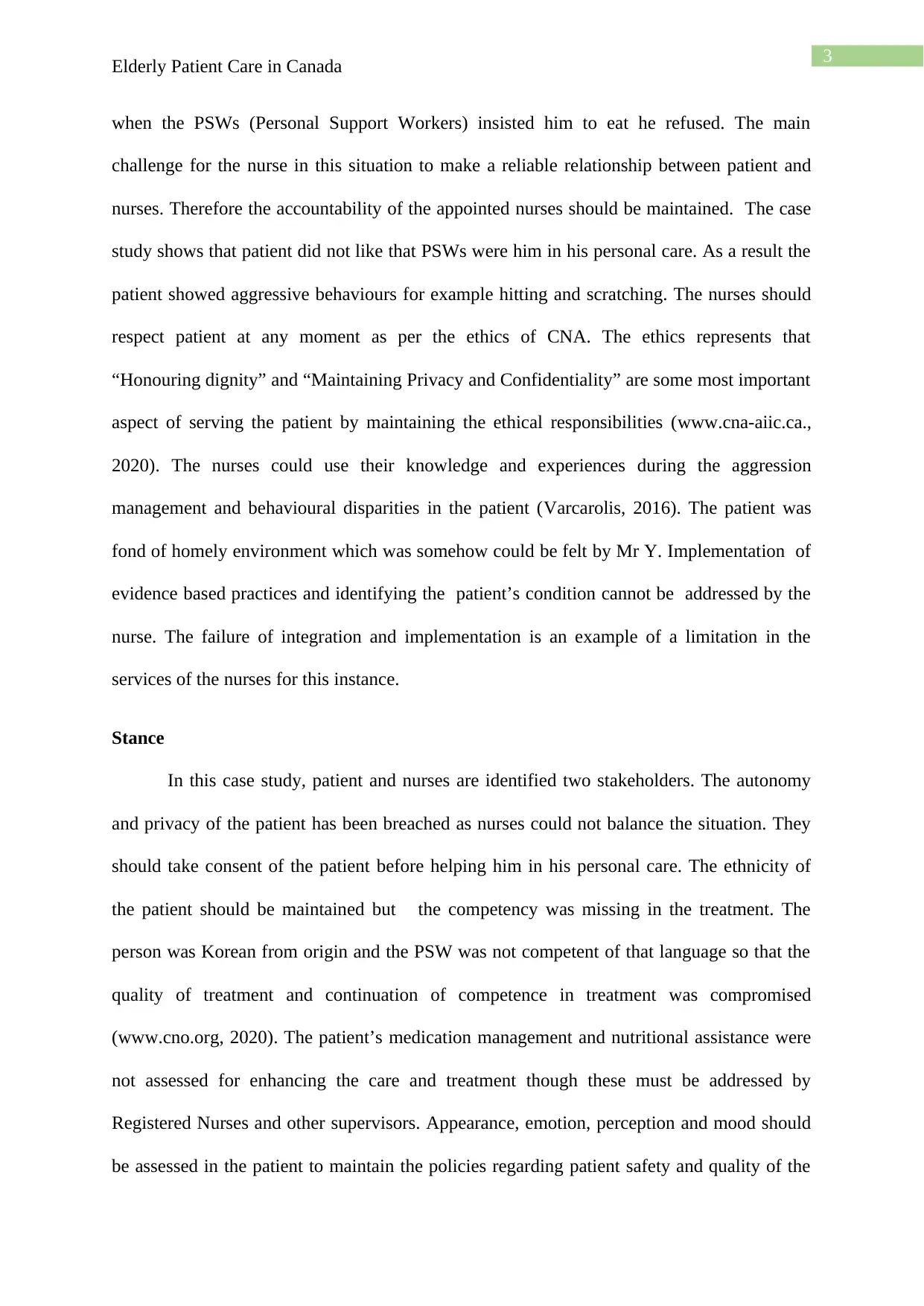
3
Elderly Patient Care in Canada
when the PSWs (Personal Support Workers) insisted him to eat he refused. The main
challenge for the nurse in this situation to make a reliable relationship between patient and
nurses. Therefore the accountability of the appointed nurses should be maintained. The case
study shows that patient did not like that PSWs were him in his personal care. As a result the
patient showed aggressive behaviours for example hitting and scratching. The nurses should
respect patient at any moment as per the ethics of CNA. The ethics represents that
“Honouring dignity” and “Maintaining Privacy and Confidentiality” are some most important
aspect of serving the patient by maintaining the ethical responsibilities (www.cna-aiic.ca.,
2020). The nurses could use their knowledge and experiences during the aggression
management and behavioural disparities in the patient (Varcarolis, 2016). The patient was
fond of homely environment which was somehow could be felt by Mr Y. Implementation of
evidence based practices and identifying the patient’s condition cannot be addressed by the
nurse. The failure of integration and implementation is an example of a limitation in the
services of the nurses for this instance.
Stance
In this case study, patient and nurses are identified two stakeholders. The autonomy
and privacy of the patient has been breached as nurses could not balance the situation. They
should take consent of the patient before helping him in his personal care. The ethnicity of
the patient should be maintained but the competency was missing in the treatment. The
person was Korean from origin and the PSW was not competent of that language so that the
quality of treatment and continuation of competence in treatment was compromised
(www.cno.org, 2020). The patient’s medication management and nutritional assistance were
not assessed for enhancing the care and treatment though these must be addressed by
Registered Nurses and other supervisors. Appearance, emotion, perception and mood should
be assessed in the patient to maintain the policies regarding patient safety and quality of the
Elderly Patient Care in Canada
when the PSWs (Personal Support Workers) insisted him to eat he refused. The main
challenge for the nurse in this situation to make a reliable relationship between patient and
nurses. Therefore the accountability of the appointed nurses should be maintained. The case
study shows that patient did not like that PSWs were him in his personal care. As a result the
patient showed aggressive behaviours for example hitting and scratching. The nurses should
respect patient at any moment as per the ethics of CNA. The ethics represents that
“Honouring dignity” and “Maintaining Privacy and Confidentiality” are some most important
aspect of serving the patient by maintaining the ethical responsibilities (www.cna-aiic.ca.,
2020). The nurses could use their knowledge and experiences during the aggression
management and behavioural disparities in the patient (Varcarolis, 2016). The patient was
fond of homely environment which was somehow could be felt by Mr Y. Implementation of
evidence based practices and identifying the patient’s condition cannot be addressed by the
nurse. The failure of integration and implementation is an example of a limitation in the
services of the nurses for this instance.
Stance
In this case study, patient and nurses are identified two stakeholders. The autonomy
and privacy of the patient has been breached as nurses could not balance the situation. They
should take consent of the patient before helping him in his personal care. The ethnicity of
the patient should be maintained but the competency was missing in the treatment. The
person was Korean from origin and the PSW was not competent of that language so that the
quality of treatment and continuation of competence in treatment was compromised
(www.cno.org, 2020). The patient’s medication management and nutritional assistance were
not assessed for enhancing the care and treatment though these must be addressed by
Registered Nurses and other supervisors. Appearance, emotion, perception and mood should
be assessed in the patient to maintain the policies regarding patient safety and quality of the
Secure Best Marks with AI Grader
Need help grading? Try our AI Grader for instant feedback on your assignments.

4
Elderly Patient Care in Canada
treatment. There are several lacks or gaps in the treatment of Mr Y as no healthcare
professionals assessed the mood and behaviours of the patient. The preferences of the patient
were not taken under the consideration for the treatment. According to the case study, the
patient was not feeling familiar and competent during the treatment as the PSW could not
maintained the language (Kim et al., 2020).
Critical Analysis
The nurses should maintain the conducts to manage aggressive or psychologically
distressed patient. They should maintain their patience and balance all the national and
international policies regarding the nursing interventions such as better communication and
family involvement in the treatment. Thus managing primary concerns such as personal
hygiene, medication management and therapeutic relationship could be maintained in a very
effective way. Family involvement in the treatment would result better responses from the
patients. Communication and assessment strategies should be continued to maintain the
competence of the treatment procedure. Involvement of the multidisciplinary teams and
therapeutic treatment experts can help Mr Y in better cognition and better behavioural
development (Brenes et al., 2019). However the patient was involved in the creative therapies
or the engagements provided by the hospital authority. The creative engagement helps him to
maintain his mindfulness and satisfaction. The cognition was supported by this initiative and
more interaction should be involved with patient. His medication lists should be checked by
the experts and suggestions of medication should be appropriate with the past medical
history.
Conclusion
Nurses should be more careful about their responsibilities for treating the patients like
Mr Y. There are multiple policies which should be addressed during the patient’s treatment.
Elderly Patient Care in Canada
treatment. There are several lacks or gaps in the treatment of Mr Y as no healthcare
professionals assessed the mood and behaviours of the patient. The preferences of the patient
were not taken under the consideration for the treatment. According to the case study, the
patient was not feeling familiar and competent during the treatment as the PSW could not
maintained the language (Kim et al., 2020).
Critical Analysis
The nurses should maintain the conducts to manage aggressive or psychologically
distressed patient. They should maintain their patience and balance all the national and
international policies regarding the nursing interventions such as better communication and
family involvement in the treatment. Thus managing primary concerns such as personal
hygiene, medication management and therapeutic relationship could be maintained in a very
effective way. Family involvement in the treatment would result better responses from the
patients. Communication and assessment strategies should be continued to maintain the
competence of the treatment procedure. Involvement of the multidisciplinary teams and
therapeutic treatment experts can help Mr Y in better cognition and better behavioural
development (Brenes et al., 2019). However the patient was involved in the creative therapies
or the engagements provided by the hospital authority. The creative engagement helps him to
maintain his mindfulness and satisfaction. The cognition was supported by this initiative and
more interaction should be involved with patient. His medication lists should be checked by
the experts and suggestions of medication should be appropriate with the past medical
history.
Conclusion
Nurses should be more careful about their responsibilities for treating the patients like
Mr Y. There are multiple policies which should be addressed during the patient’s treatment.
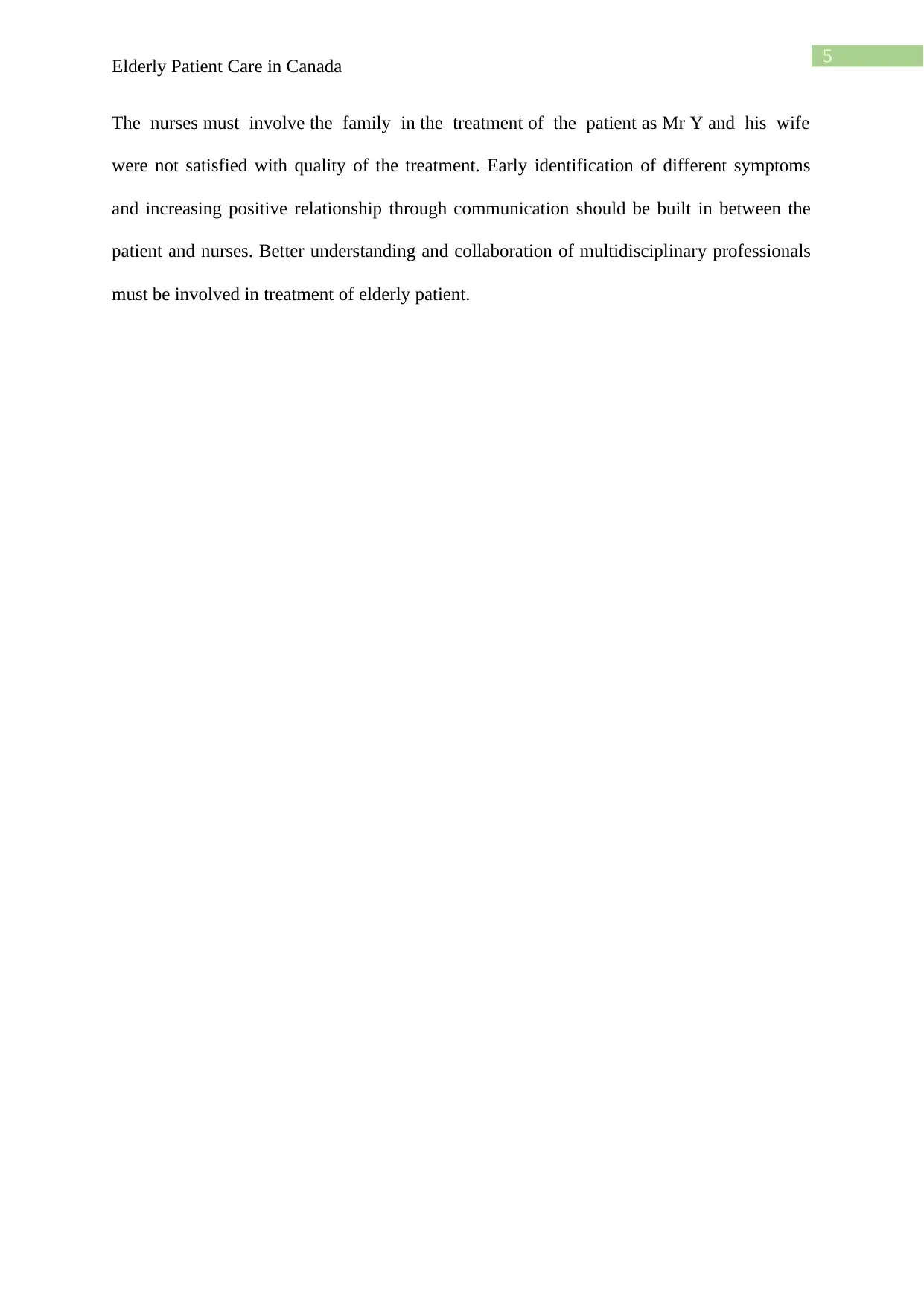
5
Elderly Patient Care in Canada
The nurses must involve the family in the treatment of the patient as Mr Y and his wife
were not satisfied with quality of the treatment. Early identification of different symptoms
and increasing positive relationship through communication should be built in between the
patient and nurses. Better understanding and collaboration of multidisciplinary professionals
must be involved in treatment of elderly patient.
Elderly Patient Care in Canada
The nurses must involve the family in the treatment of the patient as Mr Y and his wife
were not satisfied with quality of the treatment. Early identification of different symptoms
and increasing positive relationship through communication should be built in between the
patient and nurses. Better understanding and collaboration of multidisciplinary professionals
must be involved in treatment of elderly patient.
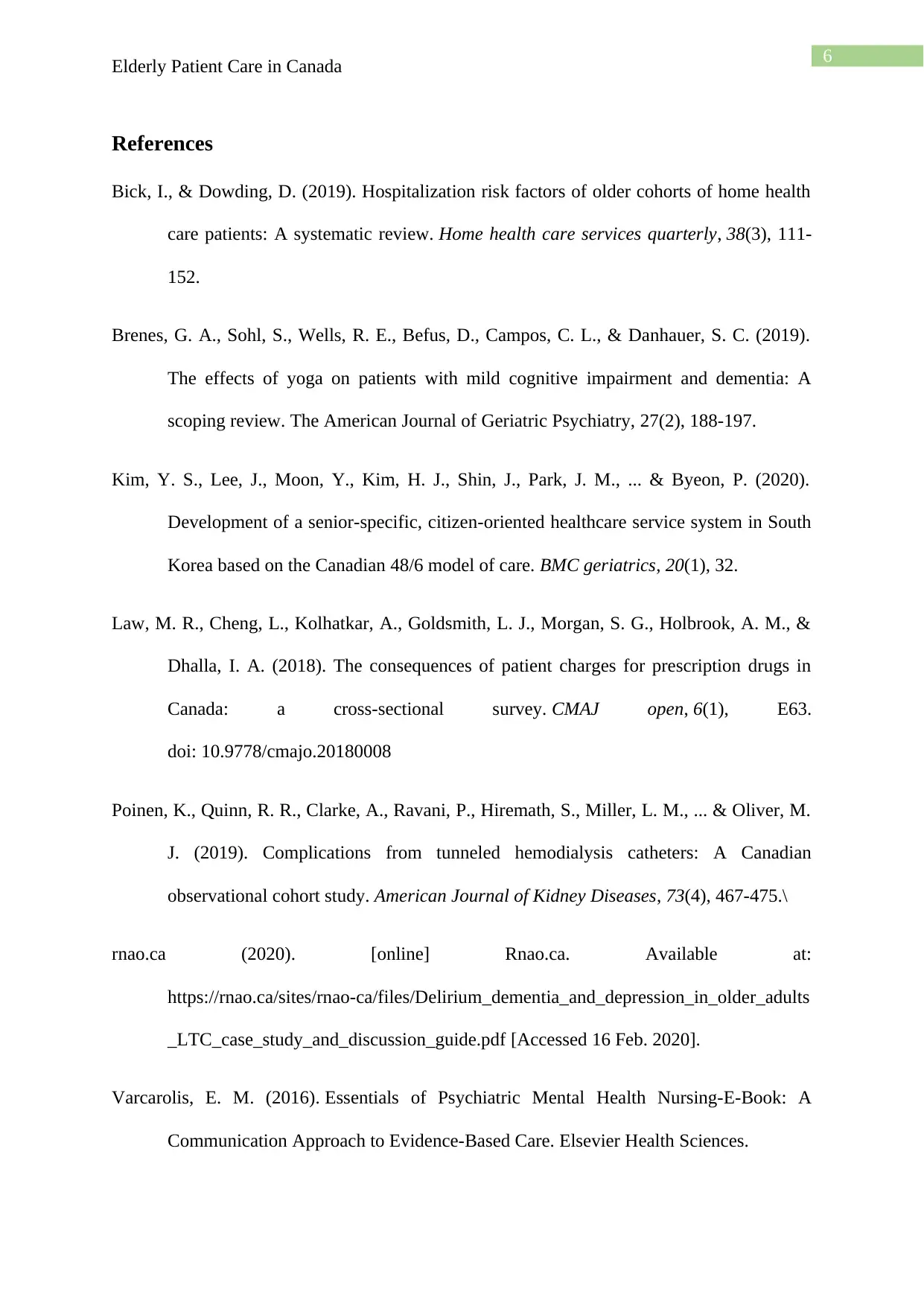
6
Elderly Patient Care in Canada
References
Bick, I., & Dowding, D. (2019). Hospitalization risk factors of older cohorts of home health
care patients: A systematic review. Home health care services quarterly, 38(3), 111-
152.
Brenes, G. A., Sohl, S., Wells, R. E., Befus, D., Campos, C. L., & Danhauer, S. C. (2019).
The effects of yoga on patients with mild cognitive impairment and dementia: A
scoping review. The American Journal of Geriatric Psychiatry, 27(2), 188-197.
Kim, Y. S., Lee, J., Moon, Y., Kim, H. J., Shin, J., Park, J. M., ... & Byeon, P. (2020).
Development of a senior-specific, citizen-oriented healthcare service system in South
Korea based on the Canadian 48/6 model of care. BMC geriatrics, 20(1), 32.
Law, M. R., Cheng, L., Kolhatkar, A., Goldsmith, L. J., Morgan, S. G., Holbrook, A. M., &
Dhalla, I. A. (2018). The consequences of patient charges for prescription drugs in
Canada: a cross-sectional survey. CMAJ open, 6(1), E63.
doi: 10.9778/cmajo.20180008
Poinen, K., Quinn, R. R., Clarke, A., Ravani, P., Hiremath, S., Miller, L. M., ... & Oliver, M.
J. (2019). Complications from tunneled hemodialysis catheters: A Canadian
observational cohort study. American Journal of Kidney Diseases, 73(4), 467-475.\
rnao.ca (2020). [online] Rnao.ca. Available at:
https://rnao.ca/sites/rnao-ca/files/Delirium_dementia_and_depression_in_older_adults
_LTC_case_study_and_discussion_guide.pdf [Accessed 16 Feb. 2020].
Varcarolis, E. M. (2016). Essentials of Psychiatric Mental Health Nursing-E-Book: A
Communication Approach to Evidence-Based Care. Elsevier Health Sciences.
Elderly Patient Care in Canada
References
Bick, I., & Dowding, D. (2019). Hospitalization risk factors of older cohorts of home health
care patients: A systematic review. Home health care services quarterly, 38(3), 111-
152.
Brenes, G. A., Sohl, S., Wells, R. E., Befus, D., Campos, C. L., & Danhauer, S. C. (2019).
The effects of yoga on patients with mild cognitive impairment and dementia: A
scoping review. The American Journal of Geriatric Psychiatry, 27(2), 188-197.
Kim, Y. S., Lee, J., Moon, Y., Kim, H. J., Shin, J., Park, J. M., ... & Byeon, P. (2020).
Development of a senior-specific, citizen-oriented healthcare service system in South
Korea based on the Canadian 48/6 model of care. BMC geriatrics, 20(1), 32.
Law, M. R., Cheng, L., Kolhatkar, A., Goldsmith, L. J., Morgan, S. G., Holbrook, A. M., &
Dhalla, I. A. (2018). The consequences of patient charges for prescription drugs in
Canada: a cross-sectional survey. CMAJ open, 6(1), E63.
doi: 10.9778/cmajo.20180008
Poinen, K., Quinn, R. R., Clarke, A., Ravani, P., Hiremath, S., Miller, L. M., ... & Oliver, M.
J. (2019). Complications from tunneled hemodialysis catheters: A Canadian
observational cohort study. American Journal of Kidney Diseases, 73(4), 467-475.\
rnao.ca (2020). [online] Rnao.ca. Available at:
https://rnao.ca/sites/rnao-ca/files/Delirium_dementia_and_depression_in_older_adults
_LTC_case_study_and_discussion_guide.pdf [Accessed 16 Feb. 2020].
Varcarolis, E. M. (2016). Essentials of Psychiatric Mental Health Nursing-E-Book: A
Communication Approach to Evidence-Based Care. Elsevier Health Sciences.
Paraphrase This Document
Need a fresh take? Get an instant paraphrase of this document with our AI Paraphraser
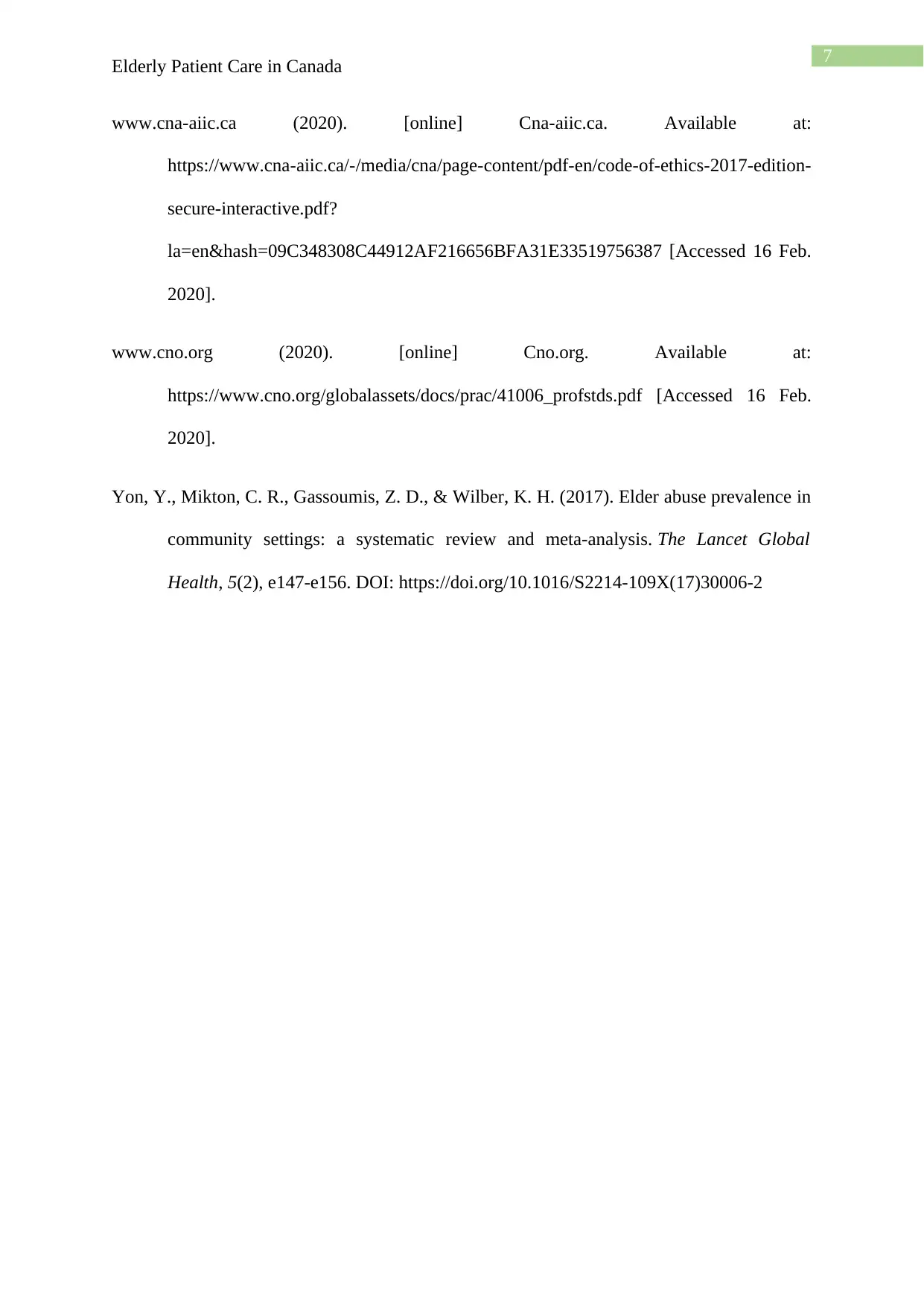
7
Elderly Patient Care in Canada
www.cna-aiic.ca (2020). [online] Cna-aiic.ca. Available at:
https://www.cna-aiic.ca/-/media/cna/page-content/pdf-en/code-of-ethics-2017-edition-
secure-interactive.pdf?
la=en&hash=09C348308C44912AF216656BFA31E33519756387 [Accessed 16 Feb.
2020].
www.cno.org (2020). [online] Cno.org. Available at:
https://www.cno.org/globalassets/docs/prac/41006_profstds.pdf [Accessed 16 Feb.
2020].
Yon, Y., Mikton, C. R., Gassoumis, Z. D., & Wilber, K. H. (2017). Elder abuse prevalence in
community settings: a systematic review and meta-analysis. The Lancet Global
Health, 5(2), e147-e156. DOI: https://doi.org/10.1016/S2214-109X(17)30006-2
Elderly Patient Care in Canada
www.cna-aiic.ca (2020). [online] Cna-aiic.ca. Available at:
https://www.cna-aiic.ca/-/media/cna/page-content/pdf-en/code-of-ethics-2017-edition-
secure-interactive.pdf?
la=en&hash=09C348308C44912AF216656BFA31E33519756387 [Accessed 16 Feb.
2020].
www.cno.org (2020). [online] Cno.org. Available at:
https://www.cno.org/globalassets/docs/prac/41006_profstds.pdf [Accessed 16 Feb.
2020].
Yon, Y., Mikton, C. R., Gassoumis, Z. D., & Wilber, K. H. (2017). Elder abuse prevalence in
community settings: a systematic review and meta-analysis. The Lancet Global
Health, 5(2), e147-e156. DOI: https://doi.org/10.1016/S2214-109X(17)30006-2
1 out of 8
Related Documents
Your All-in-One AI-Powered Toolkit for Academic Success.
+13062052269
info@desklib.com
Available 24*7 on WhatsApp / Email
![[object Object]](/_next/static/media/star-bottom.7253800d.svg)
Unlock your academic potential
© 2024 | Zucol Services PVT LTD | All rights reserved.





